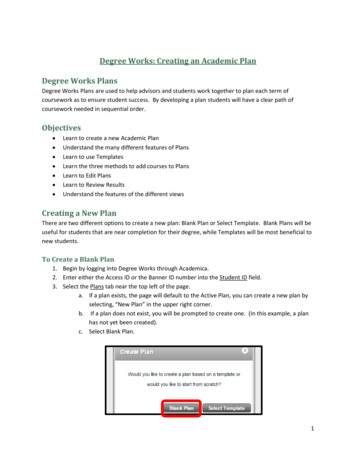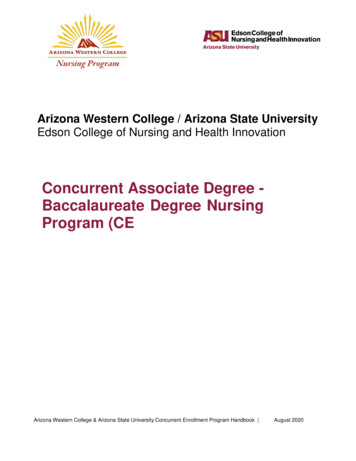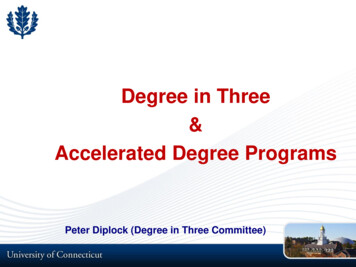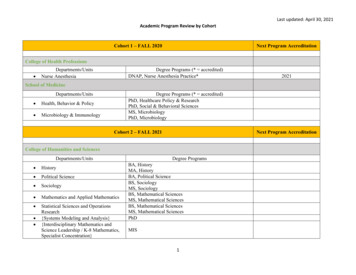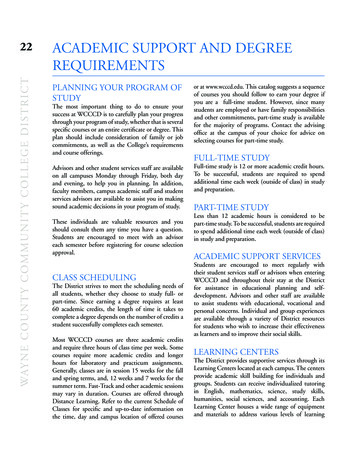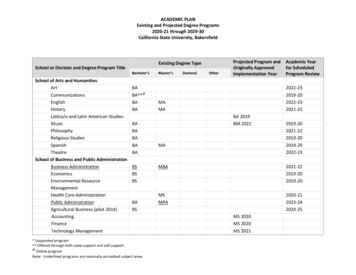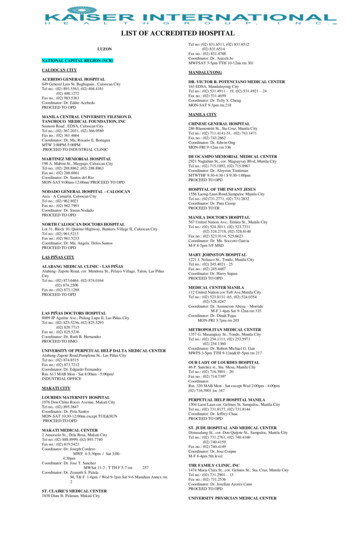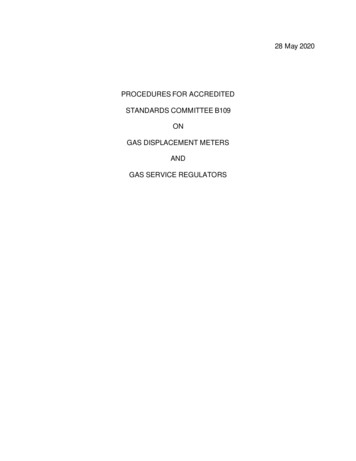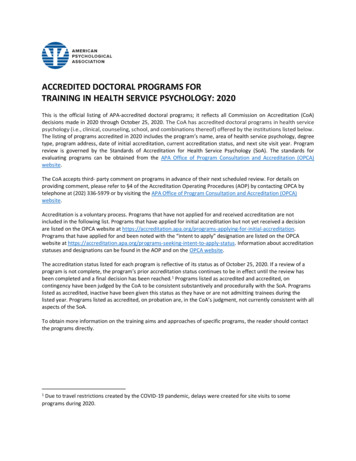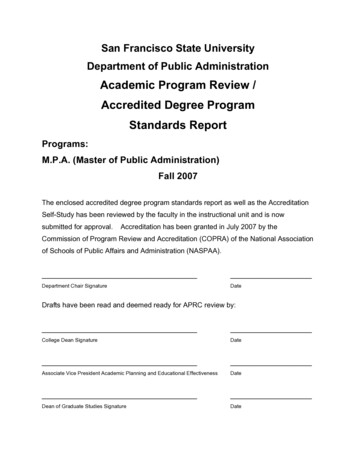
Transcription
San Francisco State UniversityDepartment of Public AdministrationAcademic Program Review /Accredited Degree ProgramStandards ReportPrograms:M.P.A. (Master of Public Administration)Fall 2007The enclosed accredited degree program standards report as well as the AccreditationSelf-Study has been reviewed by the faculty in the instructional unit and is nowsubmitted for approval.Accreditation has been granted in July 2007 by theCommission of Program Review and Accreditation (COPRA) of the National Associationof Schools of Public Affairs and Administration (NASPAA).Department Chair SignatureDateDrafts have been read and deemed ready for APRC review by:College Dean SignatureDateAssociate Vice President Academic Planning and Educational EffectivenessDateDean of Graduate Studies SignatureDate
Department of Public Administration Report to APRCTable 14Grid to accompany narrative submitted by accredited programsStandardIs standard being met?Locationdiscussed inaccreditationreportsUniversity-wide standards3.0 ADMISSION REQUIREMENTS3.1 Evidence of Prior Academic Yes, standard is met; 100% of applicants meet thisSuccessstandard.3.2 Evidence of CompetentYes, standard is met; 100% required to take and passWritingGET; if do not pass, must take writing course.3.3 English Preparation of Non- Yes, standard is met; 100% non-Native Speakers mustNative Speakersmeet minimum TOEFL score.3.4 Overview of ProgramStandard is met.Admissions Policy4.0 PROGRAM REQUIREMENTS4.1 Number of course offeringsYes, standard is met. 12 offered in SP07; 13 in Fall 07plus 2 in San Mateo Cohort Program.4.2 Frequency of courseYes, standard is met. Core courses 2-3 times per year /offeringsElectives 1x per 3 semesters.4.3 Path to graduationYes, standard is met. Available at http://bss.sfsu.edu/ mpa and http://bss.sfsu.edu/ mpa/documents/steps to graduation.pdf ; Self-Study indicates 7 semestermedian to graduation, 6 is mode.4.4 Course distribution on GAPYes, standard is met. No undergraduate courses inM.P.A. curriculum. One elective (PA 782 / 582) is paired.Undergraduate courses from other departments areallowed in elective emphases.4.5 Class sizeYes, standard is met. 2 classes in 03-04 were 32; oneclass in 05-06 was 37. Since, have reduced admissionsand no classes over 30.4.6 Number of graduatesYes, standard is met. Average of 34 graduates per yearover 5 years; most recent were 48 (04-05), 43 (05-06),and 40 (06-07).5.0 FACULTY REQUIREMENTS5.1 Number of Faculty inGraduate Program(s)5.2 Number of Faculty ppendix 1here.69, 7072-7337, 63, 64-68,74-7793-94, 95128Yes, standard is met. As of Fall 2007 will have 6.0 FTEF,including one replacement search in 07-08.Yes, standard will be met after curriculum proposal wasapproved by Senate. Have at least one for all emphasesafter deleting Integrated and Collaborative ServiceDelivery.80-82Yes, the standards are met.9-247.0 THE STUDENTEXPERIENCEYes, the standards are met.44-45, 73-74,1368.0 THE PROGRAM AND THECOMMUNITYYes, the standards are met.53, 90-1009.0 THE FACULTYEXPERIENCEYes, the standards are met.98, 14210.0 RESOURCE SUPPORTFOR THE PROGRAMYes, the standards are met.Section 10here.Program-Specific Standards6.0 PROGRAM PLANNINGPROCESS124-125curriculumrevisionproposal1
Department of Public Administration Report to APRC3.0 Admission Requirements3.1 Evidence of Prior Academic SuccessThe Department of Public Administration meets the University standard of a 3.0minimum grade point average for admissions. As shown on pages 112 and 113 of theSelf-Study, all Program materials and Figure 1, the Department of Public Administrationrequires a minimum of a 3.0 grade point average for admissions. Further, this standardis strictly maintained, as seen in Figure 1. The median grade point average for the pastthree years has only been as low as 3.4 in one semester and is typically 3.5 or 3.6 butthe minimum grade point average of any admitted student has never gone below 3.0.Figure 1: Grade Point Averages of Department of Public AdministrationAdmitted Students, Spring 2004 – Fall 20073.2 Evidence of Competent WritingAs required by the new standards, all students are required to produce evidenceof competent writing. Public Administration students all take the San Francisco State2
Department of Public Administration Report to APRCUniversity Graduate Essay Test and must achieve a passing grade (see all admissionsmaterials and the Bulletin). Those who achieve only a marginal pass or who fail arerequired to pass an additional writing course.3.3 English Preparation of Non-Native SpeakersThe Department of Public Administration meets the University standard ofrequiring English preparation. As seen on page 109 of the Self-Study, all incominginternational students must achieve at least a 550 on the paper based TOEFL, 213 onthe computer based test, or 80 on the Internet based test). Students are never granteda waiver of the TOEFL requirement.3.4 Overview of Program Admissions PolicyThe admissions policy of the Department of Public Administration has changed inthe past four years from one in which all students who met the minimum standards wereaccepted to one which is highly competitive. In Fall 2006, only 48 percent of those whoapplied were admitted to the Program. Fall 2007 presented an unusual situation, sincewe were doing one-time only admissions of the San Mateo County Cohort Programstudents. Fifty-three percent of the San Mateo and on-campus applicants togetherwere admitted. This means that on-campus applicants were admitted at a far lowerrate, since informational meetings in San Mateo County had effectively educatedapplicants not to apply unless they met the standards.4.0 Program Requirements4.1 Number of Course OfferingsThe Department of Public Administration more than meets the standard of twocourses offered per term. The number of course offerings each semester ranges from11 (Fall 2006) to 12 (Spring 2007) to 13 plus 2 in San Mateo (Fall 2007) graduateofferings per semester. Care is taken to ensure that electives are offered each term foreach elective emphasis. Students are also allowed to take interdisciplinary electivesfrom across the campus as well.4.2 Frequency of Course OfferingsThe Department of Public Administration meets the University standard ofoffering every course once every two years. Core courses are offered at least two timesper year (the introductory PA 700 is offered three times per year) and electives areoffered once every three semesters (pages 69 and 70, Self-Study).Tentative course offerings are presented on the Program’s website athttp://bss.sfsu.edu/ mpa/schedule/tentative.htm. The tentative course schedulecurrently listed covers up to Spring 2010.4.3 Path to GraduationThe Department of Public Administration meets the standard of providing acourse schedule that clearly states a path to graduation allowing students to graduate3
Department of Public Administration Report to APRCwithin five years. The Department of Public Administration’s paths to graduation areavailable at http://bss.sfsu.edu/ mpa/documents/ steps to graduation.pdf, as seen onpages 72 and 73 of the Self-Study.Figure 4-2 on page 72 of the Self-Study shows clearly that, of those students inthe 2005-2006 cohort, most graduated in six (mode) or seven (median) semesters.Only two students took ten semesters (including summers) to complete the programand 4 students took 11 semesters (including summers); therefore, all graduated in lessthan five years of consecutive work. Some took longer than five calendar yearsbecause they left the Program and then returned some time afterwards to complete theProgram.4.4 Course Distribution on GAPThe Department of Public Administration more than meets this Universitystandard of at least 50 percent graduate courses in each student’s Graduate ApprovedProgram.In our case, each student’s GAP (Graduate Approved Program) will alwayscontain at least 27 graduate units out of a total 39 to 43 units. The 27 units arecomprised of 24 units of core courses plus the culminating experience. This meansstudents will take a total of at least 62.8 to 69.2 percent graduate courses, dependingon whether or not they take the internship class. In most cases, the total number ofgraduate units students take is higher, as at least one of their elective courses are alsograduate courses.Table 1: Distribution of Courses on GAPGraduate UnitsCore CoursesElective UnitsCulminatingExperienceInternshipTotal24 unitsAdvise / Insist on at least 3-6 units3 unitsFall 2007—4 unitsAt least 27 units (69.2%)with no internship / 62.8%with internship up to Sp07 / 31 units (72.1%) afterF07Under graduateUnits0Can include someupper divisionundergraduate units0Up until Spring2007—4 unitsSome elective unitsand internship upuntil Sp 07Total24 units12 units3 units4 units39 units wheninternship is waived /43 units withinternshipIn Fall 2007, the Department of Public Administration will be using its owninternship courses. Therefore, after Fall 2007, students taking the internship willcomplete at least 72.1 percent graduate courses.4
Department of Public Administration Report to APRCStudents may take upper division courses as part of their 12 unit electiverequirement. However, they are advised that they must take some graduate courseelectives as well. As seen in the Self-Study (pp. 74-77), in no case did a student useundergraduate courses for all of their electives.The Department of Public Administration curriculum has only one paired course,PA 782: Community and Economic Development.4.5 Class SizeThe Department of Public Administration now meets the University standard ofmaintaining a class size of between 8 and 30 students with an average class size of19.9 students in 2005-2006. In 2006-2007 the average class size was 22.45. Coreclasses have more students than do elective courses. In 2006-2007, core classes hadan average class size of 26.6 and elective courses had an average class size of 18.3. In Fall 2005, there were two electives with enrollments of 5 (PA 750: PublicFinancial Management) and 8 (PA 752: Public Administration and the Law)students, respectively. One class was comprised of 37 students in 2005-2006as the result of the transition from one methods course to a two coursesequence. In that case the class included students from two admissionscohorts waiting to enter that class and was an anomaly.By Spring 2006, however, all courses met the standard (one [PA 784:Intergovernmental Relations] appeared to be lower but it was cross-listed withPolitical Science and the total was greater than 8).In Fall 2006, only one course (PA 705: Research Methods and Analysis I)exceeded the standard by one student, at 31. This problem was alleviated byputting into place our plan for offering PA 705 and PA 706 two times per year,beginning Spring 2007. No courses were smaller than 8 students.In Spring 2007, all courses had class sizes between 8 and 30.The Department of Public Administration saw a period of extreme growthbeginning in 2003 and continuing until 2005; during this period, the Program struggledwith class sizes that were too large. This growth has been contained by an activeenrollment management strategy involving the reduction of admissions to the Program.Subsequently, class sizes have been reduced. During this period of growth, however,there were two classes in 2003-2004 that contained 32 students.The Department of Public Administration now meets the University standard ofno more than 30 students per class. Table 5-8 and Figure 5-2 on pages 94-95 of theSelf-Study provide additional details.4.6 Number of GraduatesSince 40 students graduated in 2006-2007, the Department of PublicAdministration meets the University standard of graduating at least an average of five5
Department of Public Administration Report to APRCstudents per year over a five year period, with an average of 40.2 graduates over theperiod from 2002-2003 to 2006-2007 (40, 30, 48, 43, 40).Figure 2-3 on page 8 of the Self-Study illustrates this finding for the five yearsbeginning in 2001-2002 and ending in 2005-2006. The Program instituted a majorchange in the culminating experience options that took effect in the Fall of 2002 with thecreation of a capstone course with a written comprehensive examination as an option.This Figure shows the enormous difference this change made in the number ofgraduates; before this change, the number of graduates ranged from 9 to 16 and afterthe change, the number of graduates ranged from 30 to 48.5.0 Faculty Requirements5.1 Number of Faculty in Graduate ProgramThe Department of Public Administration meets this standard of at least twofaculty per graduate degree. Currently we have five tenure / tenure track faculty presentplus one resignation in 2006-2007 (Dr. Laurie Paarlberg), for a total of 6.0 tenure /tenure track lines. We successfully conducted two faculty searches last year and thosetwo new faculty members just arrived to teach in the Fall 2007 semester. We havebeen granted permission to search for a replacement for Dr. Paarlberg and that searchis currently ongoing.5.2 Number of Faculty per ConcentrationSince our Spring 2007 curriculum proposal was approved by the Graduate Deanand Academic Senate, the Department of Public Administration meets the standard ofat least one faculty member per elective emphasis. Within that proposal was therequest to delete the Integrated and Collaborative Service Delivery elective emphasis.Dr. Marjorie Seashore was the advisor for that area; with her retirement, there is noother faculty member for that area. That and the low enrollments in that emphasiscreated the rationale for deleting the emphasis.6.0 Program Planning ProcessThe Department of Public Administration meets the University standard of havingan active planning process and using student learning outcomes assessment results toimprove our Program. The Department of Public Administration began an active andcontinuing strategic planning process in 1998; the original plan was updated andchanged three times as goals were achieved and new goals developed. An entirelynew strategic plan was developed in 2006. The faculty will be having a retreat onAugust 24th to develop the implementation plan for the 2006 Strategic Plan.Student learning outcomes assessment began in 2002. The assessmentstrategy has been refined over the years and is now quite comprehensive, includingboth direct and indirect measures of student learning outcomes. The comprehensive listof programmatic and curricular changes made as a result of this feedback is quite6
Department of Public Administration Report to APRCextensive and includes changes in the culminating experience, internship course,information technology curriculum, and a new research methods course sequence.The Self-Study contains an in-depth section on our Program’s strategic planningprocess (page 17-18) as well as the strategic plan itself (p. 9 - 17), including the SWOTanalysis, mission statement, goals and objectives. In addition, our student learningoutcomes assessment plan can be found from pages 18 to 20. Finally, statements ofhow the results have been used to change and improve our Program are found frompages 20 through 23.The Department of Public Administration believes the performance of theDepartment and its mission and values should be fully transparent to all—students,faculty and community. Therefore, all of our strategic plan updates, all student learningoutcome assessment results, and a document stating what changes have been madeas a result of these processes are fully available to our students and the public on ourwebsite (http://bss.sfsu.edu/ mpa/faculty/strategic plan.htm).7.0 Student ExperienceThe Department of Public Administration meets the University standards forstudent learning assessment, advising, writing proficiency, and culminating experience.As discussed above, the assessment plan is available on our website and in theSelf-Study as well as our assessment results. Learning goals are part of our strategicplan and have been mapped with our courses, resulting in a student portfolio. We areplanning to move the portfolio (awarded NASPAA Best Practices as well as SFSU BestPractice award) to an e-portfolio format beginning in Fall 2007.Advising standards are quite high and meet the goals of our original 2004Advising Plan, seen on page 136 of the Self-Study. Students are encouraged to seekfrequent advising. In addition, our newly designed website provides 24 / 7 / 365advising information and students have been quite enthused with its offerings. We havea constantly updated Department of Public Administration Student Handbook availableon our website and also provide a link to the Graduate Division’s Grad Guide.The Department has made writing proficiency a crucial student learning goal (seeStrategic Plan) and is pleased to say that, from a student perspective (see Exit Surveyresults in Self-Study, pp. 44-45), the results have been positive. Students perceive animprovement in their writing effectiveness. Faculty require an extensive amount of avariety of types of writing in all of our courses and students get feedback not just oncontent but also on their writing, spelling, and punctuation.The culminating experience options were changed as a result of our strategicplanning process, as we realized the traditional social science research (applied andbasic) did not meet the needs of our professional program students. The facultyconsidered several different models and sought input from students and alumni before7
Department of Public Administration Report to APRCchanging to a capstone course and thesis options (described on pages 73 and 74 of theSelf-Study). Several students per semester take the thesis option while most opt forthe capstone, with its written comprehensive examination (called the StrategicAssessment Memorandum). The capstone format is one of case study analysis. Overtime, the faculty have continued to develop and improve it. Faculty have worked hard toensure the rigor of these two options, while also ensuring they are relevant for students’professional and career goals. Both also serve to synthesize students’ experience inthe degree program.8.0 The Program and The CommunityThe Department of Public Administration meets University standards ofinvolvement and commitment to professional engagement, civic engagement, equityand social justice and internationalization.The faculty are quite involved professionally (see faculty vitae in Self-Study) witha variety of professional organizations (American Society for Public Administration,Association for Public Policy Analysis and Management, National Association forSchools of Public Affairs and Administration, American Political Science Association,Association for Public Policy Analysis and Management and Association for Researchon Nonprofit Organizations and Voluntary Action) and have served in importantleadership roles. Students and alumni are also active in at least the local chapters ofthese organizations (particularly the American Society for Public Administration),serving on the Board of Directors and participating in the now annual Bay Area ASPATournament. Pages 98 through 100 provide summaries of this faculty professional andcommunity service.As the Program has expanded, faculty and student civic engagement hasincreased. Most faculty require course projects and students typically choose agenciesto use in completing those projects. For some courses, faculty work with agencies toprovide a “learning lab”, conducting program evaluations or fund development plans.Virtually all faculty bring agency leaders into their courses to speak on their ownexperiences.The new Strategic Plan brings civic engagement more emphasis to communityengagement as a major goal and this, together with the introduction of the Programsponsored internship, will give us a vehicle for expanding this commitment andexperience with civic eng
San Francisco State University Department of Public Administration Academic Program Review / Accredited Degree Program Standards Report Programs: M.P.A. (Master of Public Administration) Fall 2007 The enclosed accredited degree progr
